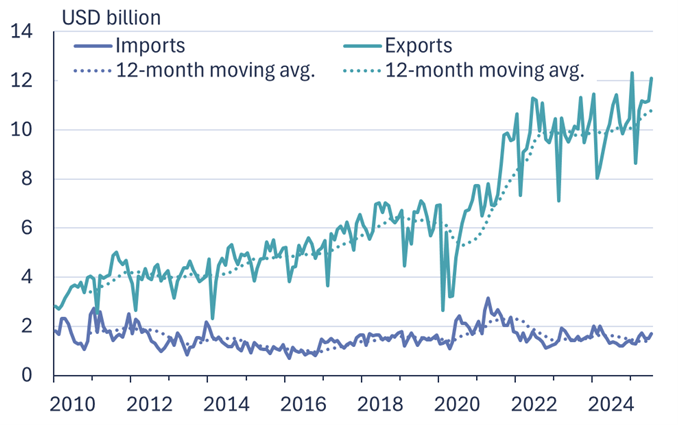BOFIT Weekly Review 34/2025
China’s exports to India on the rise, but imports remain modest
China Customs reports booming goods exports to India. This year goods exports have risen by 13 % y-o-y. After several previous years of strong performance, India has become a relatively significant export market for China. Last year, 3.4 % of China’s goods exports went to India, a slightly larger share than for goods exports to Russia or Germany. The structure of exports to India is quite typical for China. Last year, exports to India consisted of machinery & equipment (55 %), chemicals (13 %) metals (7 %) and textiles and clothing (5 %).
China Customs reports that goods imports from India have remained modest, especially given the relative size of the Indian economy. Roughly speaking, China’s imports from India have been virtually flat over the past 15 years, and last year only 0.7 % of China’s imports came from India, putting India’s share of Chinese imports roughly on par with Ireland. Commodities represent the lion’s share of China’s goods imports from India. Some 28 % of imports are extracted minerals (mainly iron ore), 17 % agricultural products, 14 % machinery & equipment, 13 % chemicals and 8 % metals. Due to the low level of imports and rising exports, China runs a substantial goods trade surplus with India. While China does not release country-specific figures on services trade, India is an internationally significant exporter of services. Thus, it is quite conceivable China has been running a services trade deficit with India.
The flows of direct investment between the two countries remain very modest. India’s commerce and industry ministry reports that China was the 23rd largest provider of foreign direct investment (FDI) to India between April 2000 and March 2025 (putting China just behind 22nd ranking Sweden). However, Chinese FDI might have partly been flowing via Hong Kong, which ranks as India’s 15th top provider, and slightly ahead of Spain (16th largest provider of FDI to India). In recent years, there has not been much FDI flowing from China or from Hong Kong’ to India, and their shares of investment in India has gradually shrunk due to increased FDI inflows from elsewhere. Indian investment in China has also been quite low in recent years. According to figures from China’s ministry of commerce, inward FDI from India has only amounted to a few million dollars a year in recent years, i.e. significantly less than the value of FDI from Finland.
This week, China’s foreign minister Wang Yi travelled to New Delhi to meet with Indian prime minister Narendra Modi, foreign minister Subrahmanyam Jaishankar and national security adviser Ajit Doval. The main purpose of the meetings was to prepare for the visit of prime minister Modi to Beijing to meet with Chinese president Xi Jinping at the end of this month as part of the annual meeting of the Shanghai Cooperation Organisation. In addition to preparing the ground for the meeting of heads of state, the countries agreed on the resumption of direct flights between China and India (direct flights were suspended in 2020) and relaxing visa practices. India also announced the opening of three Himalayan border crossings to facilitate cross-border trade.
Relations between China and India appear to be slightly on the mend. India seems to be interested to improve its ties with China, as tensions with Pakistan have escalated to military conflict this year and its relationship with the US has deteriorated. American president Donald Trump, who had already imposed high tariffs on India, announced additional tariff hikes on India from next week (Aug. 27) as punishment for India’s purchases of large quantities of Russian oil. China may see the current dynamic as an opportunity to ingratiate itself with India and drive a wedge between India and the US. However, the China-India relationship remains fragile. India sees itself as a superpower and a challenger to China, and border clashes between the two countries still flare from time to time.
China’s goods exports to India have been quite strong in recent years, while imports have remained virtually flat for 15 years

Sources: China Customs, CEIC and BOFIT.